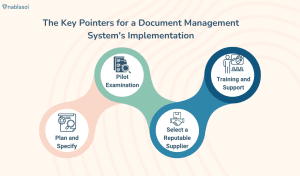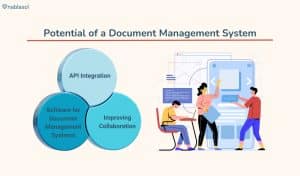Effective document management is essential for any company seeking to maintain regulation and optimize operations in the digital age. A strong Document Management System (DMS) improves business by improving the security and accessibility of critical documents while also reducing time and space. Knowing the important features and guidelines is crucial. Consider whether you’re considering integrating a digital document management system within your current infrastructure or pursuing a cloud record management solution. Everything from selecting the best DMS to putting it into practice and integrating it with other company apps will be covered in this extensive guide.
What are The Document Management System Features?
An organization can manage its document lifecycle—from creation to disposal—by implementing a File Management System, a technological solution. The following are some essential characteristics to search for:
- Cloud Document Management: A lot of the DMSs available today are cloud-based, providing high scalability. Also, remote accessibility, and less administrative overhead.
- OCR Document Management: OCR technology for Document Management Solution. It is essential for the effective retrieval of files and translates scanned printed materials into editable and accessible digital data.
- Workflow Solutions for File Upload: Automated workflows improve operational efficiency by simplifying processes like document communication and approval.
- Document Management System (DMS): A DMS should be able to do more than just store documents. It should also be able to tag, manage, and classify files to make them simpler to find.
- Record Storage Solutions: Safe archiving solutions guarantee that papers are kept in compliance with legal and regulatory standards. As well as maintained securely.
- Document Management System Function: Utilization for desktop and mobile devices improves usability by enabling users to view information at any time. Also from any location.
Selecting an Appropriate Document Management System
Choosing an effective document management solution requires taking into account several factors to make sure it meets the specifications of your company:
- Determine Your Requirements: Decide what challenges require your attention. Your demands will determine which option to choose, whether it’s for guaranteeing compliance, strengthening security, or improving access.
- Scalability: It selects a DMS that expands with your business’s growth. Scalability-wise, a cloud-based record-keeping system is commonly preferable.
- User Interface: To ensure widespread acceptance inside your company, a user-friendly interface is essential. To make sure the system satisfies their needs, test it with end users.
- Features and capability: Verify that the document management system (DMS) has any capabilities that are required, such as robust file management systems, cloud-based capabilities, and digitalized document management.
- Security: Choose a system with robust security features, such as encrypted document storage and secure access controls.
- Integration Capabilities: For seamless operations, the capacity to integrate into additional business programs, such as CRM or ERP systems, is necessary.
What kinds of industrial rules fall under the responsibility of document management systems?
Document management systems, or DMSs, can assist companies in conforming to a range of business standards, including FINRA for financial services, GDPR for data protection, SOX for financial institutions, and HIPAA for healthcare. Businesses may automate compliance to retention periods, minimize breaches of information, and guarantee the safekeeping of confidential documents by putting in place a DMS. DMS can also include version control, audit trails, and access restrictions, and it can assist firms in managing the whole document lifecycle from creation to disposal. To enhance capability and effectiveness, DMS can also link with other company software, including ERP or CRM systems. Businesses can greatly improve their chances of passing all levels of compliance by automating adherence with a DMS.
What are the key pointers for a DMS implementation?
The acceptability and effective usage of a DMS depend on its successful implementation:

- Plan and Specify: Establish a precise scope and goals at the outset. Identify the essential processes that the DMS will replace or enhance.
- Select a Reputable Supplier: A vendor with a track record of success in information management solutions should be chosen. Take a look at their support and assistance contracts.
- Training and Support: Make sure every user receives thorough training. Sufficient assistance ensures a seamless shift and deployment.
- Pilot Examination: Before going into full swing, run an informal pilot test. This method aids in the quick identification of any possible problems.
Principles for Document Management System Best Practices
Following best practices guarantees that you get the most out of your DMS:
- Frequent Audits and Updates: To keep up with emerging company issues and technological advancements, frequently examine and update the DMS.
- Strict Access boundaries: Use role-based access restrictions to guarantee that only authorized individuals can access sensitive data.
- Backup and Recovery: To prevent data loss from documents, adopt strong backup and recovery processes.
- Compliance: Conform to industry standards for information safety and management.
What is the potential of DMS in industry regulations?

A Document Management System (DMS) centralizes the storage of files and provides single-source access to every important record, greatly improving compliance with industry rules. It ensures integrity throughout the record’s development and facilitates cooperation by supporting standardized document workflows and approval procedures. To guarantee data consistency and precision, the DMS seamlessly connects with enterprise systems like ERP and can also be integrated with CRM, offers strong search features for speedy document retrieval, and automates alerts and notifications for crucial compliance tasks. It also provides strong data security with permission-based access control to safeguard sensitive information, keeps an extensive record of audits and version control for accountability and transparency, and creates compliance reports to help with proactive management and prompt modification.
Functionality and efficiency are increased by a DMS that easily interfaces with other business applications. Such as client document management software or content management systems:
- API Integration: Seek a DMS that can interface with various programs, such as accounting software, ERP, or CRM, and has robust support for APIs.
- Software for Document Management Systems: Select a program that can serve as a central location for organizing and managing documents and other kinds of content.
- Improving Collaboration: By offering a single portal for document and content access, integration promotes better collaboration.
Conclusion
Finally, firms that want to maximize efficiency, uphold compliance, and improve security. Also, accessibility to critical documents must learn how to use document management systems (DMS). Cloud file storage, OCR document management, document upload workflow solutions, file management systems, document storage solutions, and document management system apps are some of a DMS’s primary characteristics. When selecting a DMS, companies should evaluate their requirements and take into account factors like scalability, user interface, security, features and functionality, and integration capabilities. A dependable vendor, preparation and scope definition, pilot testing, training, and support are all necessary for a successful DMS implementation. Adherence to industry laws, frequent audits and updates, stringent access restrictions, backup, and recovery. Also, regular system maintenance is an example of best practices for document management systems. Organizations can realize notable gains in productivity and efficiency through the implementation of an efficient record management system, which can enhance their overall financial health, high liquidity, and client connections.
One of the best examples of this is how Microsoft Azure and Salesforce CRM were integrated, transforming company documentation management by assuring confidentiality and increasing productivity. This solution tackled several important issues, such as complying with strict security regulations. As well as automating business operations to boost efficiency, and integrate disparate consumer data. The AzureDMS provides capabilities for effective bulk operations by leveraging Microsoft Azure’s File Share Storage Services. As a result, a solid system is created that boosts decision-making, automation, productivity, and security. All of these contribute to substantial business growth and client pleasure.



